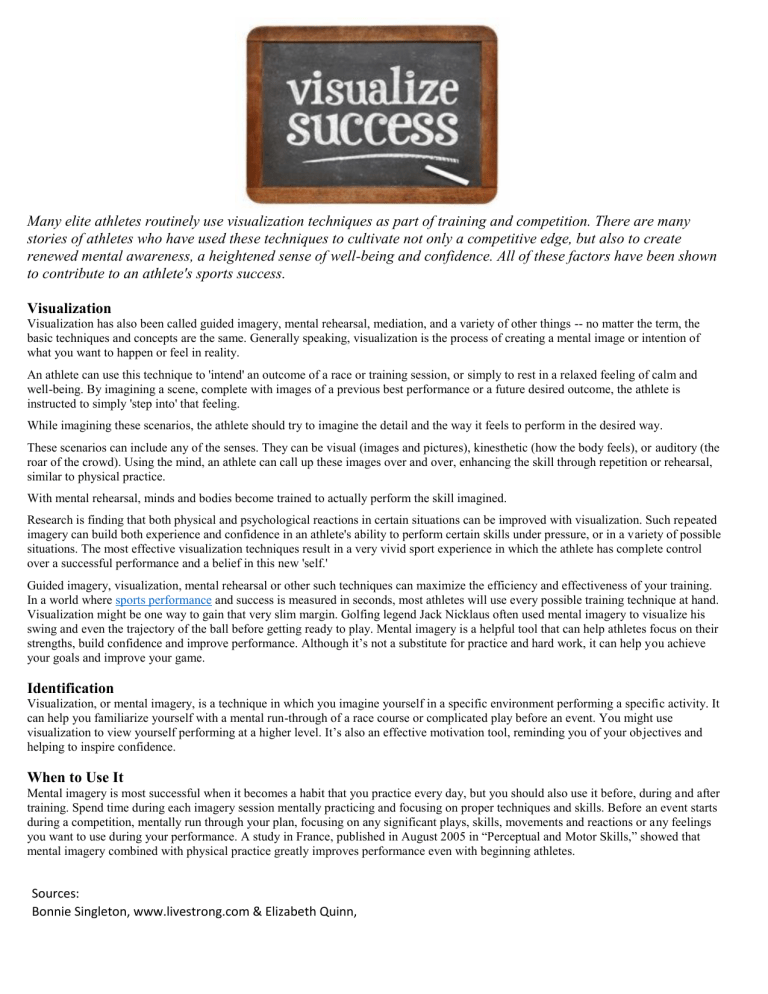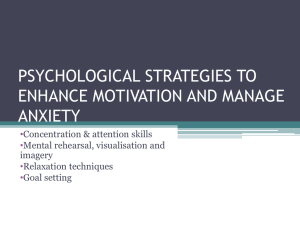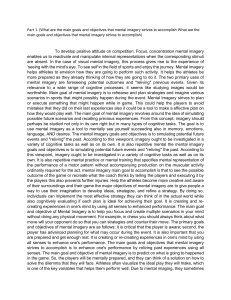
Many elite athletes routinely use visualization techniques as part of training and competition. There are many stories of athletes who have used these techniques to cultivate not only a competitive edge, but also to create renewed mental awareness, a heightened sense of well-being and confidence. All of these factors have been shown to contribute to an athlete's sports success. Visualization Visualization has also been called guided imagery, mental rehearsal, mediation, and a variety of other things -- no matter the term, the basic techniques and concepts are the same. Generally speaking, visualization is the process of creating a mental image or intention of what you want to happen or feel in reality. An athlete can use this technique to 'intend' an outcome of a race or training session, or simply to rest in a relaxed feeling of calm and well-being. By imagining a scene, complete with images of a previous best performance or a future desired outcome, the athlete is instructed to simply 'step into' that feeling. While imagining these scenarios, the athlete should try to imagine the detail and the way it feels to perform in the desired way. These scenarios can include any of the senses. They can be visual (images and pictures), kinesthetic (how the body feels), or auditory (the roar of the crowd). Using the mind, an athlete can call up these images over and over, enhancing the skill through repetition or rehearsal, similar to physical practice. With mental rehearsal, minds and bodies become trained to actually perform the skill imagined. Research is finding that both physical and psychological reactions in certain situations can be improved with visualization. Such repeated imagery can build both experience and confidence in an athlete's ability to perform certain skills under pressure, or in a variety of possible situations. The most effective visualization techniques result in a very vivid sport experience in which the athlete has complete control over a successful performance and a belief in this new 'self.' Guided imagery, visualization, mental rehearsal or other such techniques can maximize the efficiency and effectiveness of your training. In a world where sports performance and success is measured in seconds, most athletes will use every possible training technique at hand. Visualization might be one way to gain that very slim margin. Golfing legend Jack Nicklaus often used mental imagery to visualize his swing and even the trajectory of the ball before getting ready to play. Mental imagery is a helpful tool that can help athletes focus on their strengths, build confidence and improve performance. Although it’s not a substitute for practice and hard work, it can help you achieve your goals and improve your game. Identification Visualization, or mental imagery, is a technique in which you imagine yourself in a specific environment performing a specific activity. It can help you familiarize yourself with a mental run-through of a race course or complicated play before an event. You might use visualization to view yourself performing at a higher level. It’s also an effective motivation tool, reminding you of your objectives and helping to inspire confidence. When to Use It Mental imagery is most successful when it becomes a habit that you practice every day, but you should also use it before, during and after training. Spend time during each imagery session mentally practicing and focusing on proper techniques and skills. Before an event starts during a competition, mentally run through your plan, focusing on any significant plays, skills, movements and reactions or any feelings you want to use during your performance. A study in France, published in August 2005 in “Perceptual and Motor Skills,” showed that mental imagery combined with physical practice greatly improves performance even with beginning athletes. Sources: Bonnie Singleton, www.livestrong.com & Elizabeth Quinn, www.verywell.com






